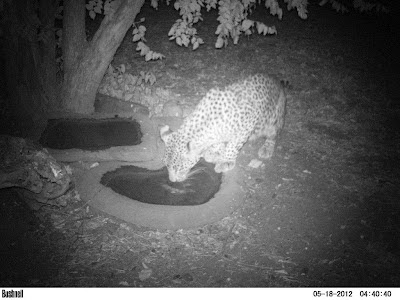During the dry season we use camera traps to try to locate and identify some of our rhino. When we first got the cameras we set them at water points, hoping to get pictures of rhino drinking but we soon learnt that all we got was literally hundreds of photos of elephants at night and guinea fowl, baboons and impala by day. After a couple of days the batteries were flat, the camera memories were full and we had learnt nothing. Now we set the cameras at the rhinos’ territorial marking spots, on game trails and at small pans that don’t attract too many elephants. There are still many more pictures of other species than of rhino but the results are often interesting.
This week we have been setting some camera traps out in the field but first we tested them after the wet season lay-off by setting them at the bird bath outside our house. The first night brought a real surprise with an elephant getting his trunk and tusks into the picture. No more than fifteen metres from the house and we didn’t even hear him
Three days later there was a particularly busy night. The first visitor was a side-striped jackal. We hear them from time to time but have never seen them in camp before though on the three or four nights we have set out the cameras so far this one has turned up every time.
Side-striped Jackal. Canis adustus
Three hours after the jackal, a grysbok came to drink.
Sharpes grysbok. Raphicerus sharpie
This is another animal we have never seen in the camp before but, like the jackal, she has turned up every night we have put out a camera.
Next arrival, not long after the grysbok was a young leopard.
Leopard. Panthera pardus
Sinamatella is good leopard habitat. We have occasionally seen them in daylight and often hear them calling at night. Last year National Parks had to trap one and release it elsewhere because it was becoming a nuisance in the staff village but normally they are very wary of humans and they keep out of our way.
One of the animals we see frequently at night is spotted hyena and just fifteen minutes after the leopard one came for a drink.
Spotted hyena Crocuta crocuta
Hyenas look rather alarming but, like the leopard, they keep away from humans as much as possible. At Sinamatella we are occasionally woken at night by hyenas raiding the dustbin outside the kitchen. We usually try to ignore the noise but sooner or later one of us reluctantly gets up, opens the kitchen door and chases the guilty hyena away. At close range by moonlight they look particularly fierce but they never stop to argue!
After that particularly successful night with the camera traps, nothing much new has been ‘captured’ apart from our resident large-spotted genet. This is a beautiful little animal that is often around the house at night. When there is food available it can be quite bold but otherwise it keeps to the bush and rocks at the side of the hill.
Large-spotted genet Genetta tigrina
Once the cameras had been tested we were able to set a few to try to ‘capture’ a rhino. One animal in particular is of interest. The spoor is too small to be an adult bull and it doesn’t scatter its dung as a territory marker so it is probably a female or a young male. We have tried tracking it but were not successful so we’ve set cameras in some of the places it frequents. We’ve also put a camera at this small spring.
We know from previous attempts that very few elephant use this water but that a rhino sometimes does. His mother was killed by poachers two years ago when he was quite small but he survived and stayed within her territory. He should be getting big enough to start wandering further afield now but we hope to get pictures of him if he is still using this spring from time to time – even if it is only once or twice a month.
While the camera is set and waiting for all that time, it is vulnerable to hyenas and elephants. The cameras are difficult to see but we have lost several to animals in the past. Hyenas chew them to pieces and elephants rip them down and throw them around so presumably they detect them by scent. We have reduced the amount of damage by smearing the cameras with mud or dung.
The first camera trap results should be seen in a week or two. Probably they will be nothing but pictures of impala and elephants – it’s a technique that requires a lot of patience. If there are any good results I’ll publish them here as they come.















